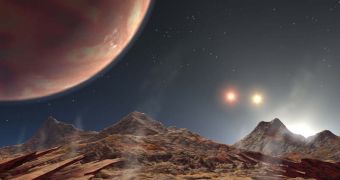Over the last decades, our solar system has been experiencing a massive sand storm, not unlike those that can be found in the desert. All the planets orbited the Sun in a halo of sand particles that is now considerably larger than it was a century ago. The reason for these large amounts of cosmic debris has kept astronomers thinking for a long time, but now they argue they may have just found the correct answer to this question. According to their calculations, the source of this inconvenience is a binary star system located not far (astronomically speaking) from the Earth.
The HD 44179 binary star system appears to be undergoing some transformation, which prompted the appearance of the large dust clouds. According to the latest researches, the Red Rectangle is the region of space hosting the double star system, which is located no more than 2,300 light-years away. The main hypothesis at this point is that one of the stars finished gorging on its vast hydrogen supply, and was, as a result, forced to collapse on itself, and convert to a less productive source of power, namely helium.
In the process, the upper layers of the star's atomosphere grew cooler, which would have offered the perfect conditions for the appearance of large masses of cosmic dust that were most likely fanned out by the solar winds of the sister star. This body could have forced the otherwise inert dust particles to pick up speed and head in various directions. Apparently, one of them is our general direction. Although this may seem like bad news, astronomers worldwide point out that the Earth will not be in immediate danger for thousands of years, until it enters the G-cloud formation, which will bring about significantly larger amounts of sand than the HD 44179 binary star system does.
“Our observations have shown that it is most likely the gravitational or tidal interaction between our Red Rectangle giant star and a close sun-like companion star that causes material to leave the envelope of the giant. The heavy elements like iron, nickel, silicon, calcium and carbon condense out into solid grains, which we see as interstellar dust, once they leave the system. Processes very similar to what we are observing in the Red Rectangle nebula have happened maybe hundreds of millions of times since the formation of the Milky Way,” Witt, an astronomer at the Apache Point Observatory in New Mexico, explains.

 14 DAY TRIAL //
14 DAY TRIAL //